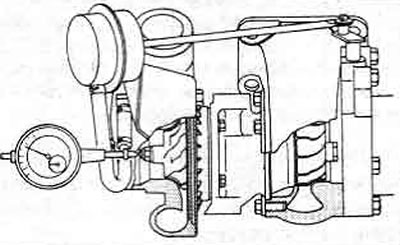Note: If any of the internal parts, such as waste gate, bearing (ov) or the seals are faulty, you will need to replace the turbogenerator as an assembly if you cannot find a specialist to repair the turbogenerator.
1. If the engine does not produce enough power, check for air leaks around the compressor, inlet/outlet pipes, or exhaust manifold.
2. If the engine produces excessive power, the cause may be a disconnected or cracked rubber hose on the bypass valve. Replace the hose.
3. If excessive oil consumption or pale blue smoke is emitted from the exhaust, check for oil leaks at the lube rope connections.
4. Further inspection requires removal of the turbogenerator.
5. On the removed turbogenerator, check the turbine wheels (blockage, deformation or other damage).
6. Rotate the wheels quickly and check that they move freely without any noise or friction.
Checking the axial clearance
7. Install the indicator through the inlet hole on the compressor cotton wool (Pic. 3.51).

Pic. 3.51. Measuring the axial clearance of a turbogenerator shaft
8. Using only hand pressure, move the turbine as far axially from the indicator as possible and install "zero". Move the turbine to the indicator, compare the measurement result with that specified in the Specifications. If the axial clearance is large, the turbogenerator must be replaced.